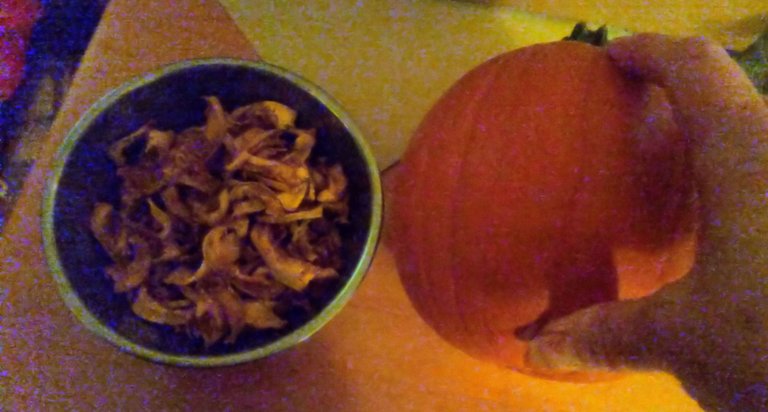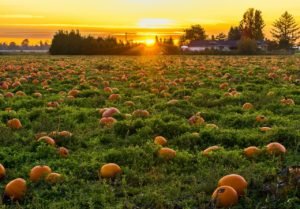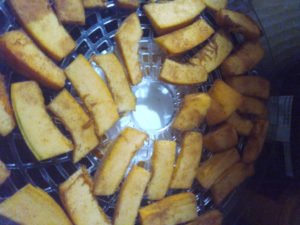
Halloween is over. Now what to do with all those pumpkins?
Most people think of using pumpkin for desserts like pumpkin pie. Some people will carve a pumpkin for Halloween and then purchase canned pumpkin puree to make pumpkin pie after having tossed out the Halloween pumpkin. They are available in abundance at this time of year. With a little bit of effort you can have pumpkin when ever you want without spending 3 or 4 bucks a can to get puree.
What Are Pumpkins?
Pumpkin is part of the winter squash family and one of the oldest domesticated plants. They are native to North America, well the round orange kind. Pumpkin fragments found in Mexico date it’s use to as early as 7,000BC.Winter squash is a collective name for several types of squash which mature in the fall. They usually have a tougher rind than summer squash and will last longer over the winter. It usually requires cooking and the skins are not eaten.
The word ‘pumpkin’ finds it’s origin from an Ancient Greek word that was then romanized to pepon meaning ‘melon’. Like many words, it evolved through the years and when 17th century colonists encountered pumpkins upon their arrival in the northeastern United States, it became ‘pumpkin’. The Wampanog people used the word ‘pohpukun’ when introducing them to the English.
Pumpkins are now grown around the world. The popularity of Halloween drives a lot of the sales followed by their use for food. An acre of pumpkins for Halloween can produce 2,500 to 3,000 pumpkins. An acre of the smaller pie pumpkins will yield more in the area of 5,000 pumpkins.

The Canadian record for the largest pumpkin was set in Ontario where the beast weighed in at 1,959lbs / 888.5kg. I think that one might be a bit much for me to dehydrate.
Dehydrating Pumpkin
Yes, this is where I’m going with this pumpkin talk. I’m not real big on using pureed pumpkin but I do enjoy pumpkin. I’ll add it to soups and stews in the winter time for a different sort of flavour. Dehydrated pumpkin can be ground into powder and added to many dishes.When the pumpkin harvest takes place in the fall, they can often be found on special. When they came on this year, I made sure to get several and then put my dehydrator to work.
Cutting into the pumpkin is the toughest part but once it’s cut, a regular potato peeler will remove the skin. Don’t toss the seeds out, they can be roasted for a treat, added to baking or even ground up. Yes, not much avoids being ground when I have a dehydrator and a coffee grinder.
I’ve been making a rustic bread recipe. It calls for 2 cups of flour. I reduce that to 1.5 cups and then substitute in other powders, like pumpkin or pumpkin seeds, to give me variety on the type of bread I’m eating. When I add pumpkin, I also add a generous dash of pumpkin pie spice.
So, the pumpkin’s been cut into sections and peeled. The seeds and the stringy mass they are attached to has been set aside to deal with. Now I slice the pumpkin into thin slices and arrange them on the dehydrator trays. About 9 hours at 160F was enough to dry them. One thing that did surprise me was the amount the pieces shrunk, indicating a high level of moisture to start with.

The seeds and that stringy mass. I found the easiest way to deal with them was to rinse and drain them before spreading them onto a dehydrator tray. I used a teflon insert on the tray to avoid any of the seeds or the ‘mass’ breaking off and falling through the tray.
Once dried, the mass will break apart when worked with your fingers leaving the seeds free. I tried just putting them onto the tray without the rinse but found they took forever to dry.
The dried mass can now be used as a powder. This means the only waste from the pumpkins was the skin. Everything else was used.
Nutritionally, both pumpkin and the seeds are healthy foods.
The benefits of pumpkin include:
- rich in Vitamin A
- Beta-carotene and alpha-carotene provide antioxidants helping to guard against diseases like cancer and eye diseases
- In addition to vitamin A, there’s also vitamin C & E, iron and folate helping to boost the immune system.
- Lutein & zeaxanthin in pumpkin is linked to lower risks of age-related macular degeneration
- Nutrient dense food meaning it has lower calories while delivering more nutrients
- Good source of fiber and potassium
The health benefit of the seeds include:
- High in magnesium, manganese, iron, zinc and copper — all of them make important health contributions. Just a single ounce serving of them can provide up to 42% of the recommended daily intake.
- High in antioxidants
- Contain several beneficial fats like Omega-3 and ALA
- Good source of plant protein which helps to control blood sugar
- Contains anti-fungal and anti-viral properties which help strengthen the immune system
Shells or No Shells?
The pumpkin seeds I extracted are in the shell. If you were to purchase pumpkin seeds at the store, they will likely be shelled. They can be eaten both ways. The shells are a source of fiber but not everyone likes the taste even after roasting.Try them and see which you prefer. If you rather then shelled, you can do so individually like sunflower seeds or you can try running a rolling pin over them to break up the shells after roasting.
Me, I’m thinking a lot can be hidden in powder added to my bread. Then I get all the fiber.
Sources:
Field of Pumpkins image -- Pexels.com
All other images belong to me.
https://en.wikipedia.org/wiki/Pumpkin
http://www.omafra.gov.on.ca/english/crops/facts/00-031.htm#yield
https://www.healthline.com/nutrition/pumpkin#TOC_TITLE_HDR_12
Here in Spain we eat lots of pumpkin, we make creamy soup during cold weather, they are a typically autumn dish simmering pumpkin dice, potato, onion and maybe a carrot, olive oil, salt and pepper, served with croutons. We usually chop it in dice and store it in the freezer. My grandma used to make also pumkin jam
I prefer to dehydrate now as it saves freezer space and will last longer if I'm not using it. I can still make dishes with it, the rehydration is very quick. It's kind of amazing how much storage space is saved by dehydrating. Right now in my kitchen there are a couple of 2L bottles. They contain what was originally 10lbs (about 5Kg) of tomatoes and red pepper.
I like that pumpkin soup idea, it contains things I enjoy. I might just put some together today since I have dehydrated onions and carrots. I've not dehydrated potato yet but have a bag sitting here that was on special so I got extra.
This was worth the read. I never knew pumpkin had more used than just Halloween decorations or costumes.
Seeing how you broke down the history, used cases, and nutritional value of the pumpkins is mind blowing
I haven't had any encounter with pumpkin (the ones I am seeing). We have a very different pumpkin over here and it's just leaves, no seeds, no skin to dispose of.
I basically just see you guys use them as decorations in movies, and cartoons especially Halloween related ones
Thanks for taking the time to take me through the journey with your pumpkin. Now, I have a better overview of it.
I love the fact that you can use those pumpkin to bake(after extraction, of course)
Cheers to you
pumpkin pie is popular at holidays like Thanksgiving and Christmas ... most of what you're seeing with the decorations is Halloween stuff.
The first comment made on this post literally stole the words out of my mouth. Heheh.
I even had to open a new tab and check if this same Halloween pumpkin is the one we have here.heheh.
We'd have pumpkin, but it's only the leaf that are used. We use it to cook soup and some other meals. As for the seed, I don't know if it's ever put to good use.
Ours is called fluted pumpkin.
Halloween is over, but I still got to learn about this stuff. All thanks to Halloween. Hehe
I just looked up Fluted Pumpkin. Interesting that the fruit is used for traditional medicine. The seeds are edible and like the North American pumpkin seeds are incredibly rich in nutritional value.
I appreciate and love your photos and content. You're doing great.
I think that a lot of the same benefits of pumpkin can be found in the canned squash sold as "pumpkin." The label mentions high vitamin A, for example. The color tells me that it also includes beta carotene. Maybe not as good, but still beneficial?
that would be the pureed pumpkin that I was referring to. Pumpkin is a type of squash and is often seen as pie filling. I'm not a fan of it but yes, the nutritional value would be there. You might want to check ingredients to see if there is additives like preservatives or sugar. One of the benefits of fresh is the lack of commercial additives.
Congratulations @shadowspub! You have completed the following achievement on the Hive blockchain and have been rewarded with new badge(s) :
Your next target is to reach 11000 comments.
You can view your badges on your board and compare yourself to others in the Ranking
If you no longer want to receive notifications, reply to this comment with the word
STOPCheck out the last post from @hivebuzz:
Support the HiveBuzz project. Vote for our proposal!
I have never cooked pumpkin! I feel like I ought to. I think I would enjoy it. I have roasted the seeds. I love them and I think I am slightly allergic to them because I get an itchy tongue after eating them. However, it might be due to the large volume of them that I tend to eat when I eat them. I usually eat the shells, but have always wondered if that was wrong of me, so thank you for clearing that up. My eating pumpkin seeds predates Google and I guess I just never bothered to check. I hope you are well.
There are so many ways to use it when you think of it as squash.
I think we mostly use pumpkin seeds for soups in my country but I'm not so sure. Can it be eaten raw? I've never seen one
I've never seen anyone comment about eating it raw. Probably best cooked since they are part of the winter squash family. Winter squash usually need to be cooked.
I've always thrown out the stringy mess, so it was interesting to learn that there is a use for it, too! 😃 I love roasted pumpkin seeds! The puree can also be used in lieu of fat in recipes, like cookies & brownies! 😊
interesting... that would hide it. I've not been a big fan of the puree. Although, I did make a chiffon pumpkin pie recipe that I found in Joy of Cooking that I enjoyed.